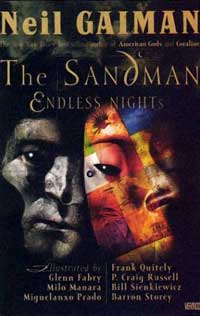Books
The Sandman: Endless Nights
By Leroy Douresseaux
October 12, 2003 - 11:04
The recently published
The Sandman: Endless Nights is likely DC’s one major contribution to the serious discussion of comic books as art this year, and maybe their lone entry for some time to come. Endless Nights may not be the best graphic novel of the year, but it is very likely the best that’s going to come from mainstream comics. And darn it, at least DC tries; with 100,000 copies printed and distribution to both comics hobby shop and bookstores, so many people are going to see an example of comics as something other than mere escapist fare.
From 1987 to 1996, fabulous comics scribe Neil Gaiman told the story of Morpheus, Lord of Dreams (also known as The Sandman) in the long running The Sandman. After 60 odd issues Gaiman closed the series, but has now returned with a 160-page hardcover to celebrate the 10th anniversary of DC’s Vertigo imprint, where the company publishes its most adult, mature, and artful work.
Endless Nights is a collection of short stories, each one focusing on one of The Endless – Dream and his siblings who also include his sister Death and his brother Destruction. The book shows why so many fans, critics, and contemporaries hold Gaiman, along with Alan Moore, in such high esteem. Not only can one marvel at the imaginative and entertaining tales herein, but Gaiman also tells them with such economy. Like Moore, Gaiman writes scripts that call for the most effective panels; he employs the most evocative language in both dialogue and exposition. He wastes little, a frivolity here or there, and he doesn’t need to decompress his stories into endless panels that would only inadequately mimic cinema.
There’s not a whole lot more to be said about the artists who drew these tales. Most of them are already world-class illustrators, graphic artists, and comic book artists. Two of them, Glenn Fabry, who is known for his comic book cover paintings, and Frank Quitely, who is known for his work with Grant Morrison, are pretty much at the point where they’re much better than the most of the material they will likely ever draw for American comic book publishers.
I wouldn’t call this book perfect, but I had an absolutely wonderful time reading every one of these wonderful fairy tales and stories of the fantastic. No, it’s not perfect, but Gaiman just put his foot against perfection’s door, and I’m sure I heard a loud crack. GRADE A
Last Updated: January 17, 2025 - 08:20
